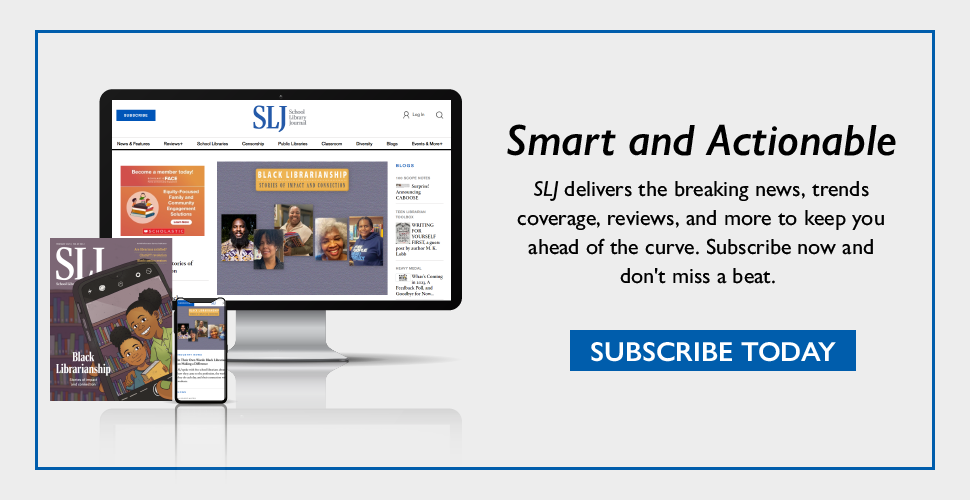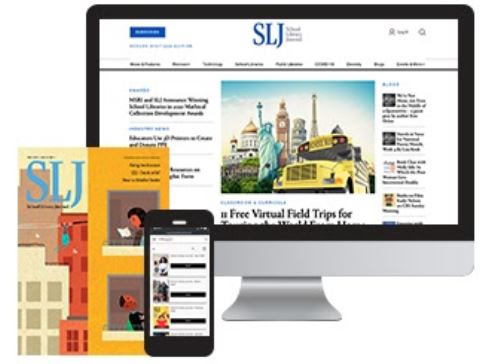Primary Sources, “Muslims in Story”, and “The Dark Fantasic” | Professional Shelf
A selection of recently published titles consider race and the imagination, girl-positive libraries, career programming, and other topics.
A selection of recently published titles consider race and the imagination, girl-positive libraries, career programming, and other topics.

 HARLAN, Mary Ann. The Girl-Positive Library: Inspiring Confidence, Creativity, and Curiosity in Young Women. 172p. bibliog. index. Libraries Unlimited/Teacher Ideas. Dec. 2018. pap. $45. ISBN 9781440860638.
HARLAN, Mary Ann. The Girl-Positive Library: Inspiring Confidence, Creativity, and Curiosity in Young Women. 172p. bibliog. index. Libraries Unlimited/Teacher Ideas. Dec. 2018. pap. $45. ISBN 9781440860638.
This well-researched, straightforward work offers librarians guidance in reading, critiquing, and recommending YA books that advance positive and accurate representation of girls and young women. Harlan discusses complex issues: character archetypes that define norms of adolescent behavior, bodily autonomy and sex positivity, and the importance of reading YA fiction through a lens of intersectional feminism. Less of a programming handbook and more of a social critique, the text provides an accessible and thorough foundation for meaningful conversations surrounding representations of girlhood in media, particularly novels and film. About half of the work is comprised of in-depth reviews of YA fiction published in the last eight to 10 years. While these titles may feel dated with time, Harlan’s meticulous review process will remain a strong example of how to dig deep into new releases and identify and question problematic narratives. The short activities section features simple but engaging ways to help patrons reflect on relevant issues. VERDICT Essential reading for librarians seeking to develop YA collections with care and purpose in order to promote social awareness and change.–Erin Downey, Boise School District, ID

 MANGLIK, Gauri & Sadaf Siddique. Muslims in Story: Expanding Multicultural Understanding Through Children’s and Young Adult Literature. 264p. illus. index. photos. ALA Editions. Sept. 2018. pap. $49.99. ISBN 9780838917411.
MANGLIK, Gauri & Sadaf Siddique. Muslims in Story: Expanding Multicultural Understanding Through Children’s and Young Adult Literature. 264p. illus. index. photos. ALA Editions. Sept. 2018. pap. $49.99. ISBN 9780838917411.
Manglik and Siddique, the CEOs of KitaabWorld, a literary organization that spreads awareness about South Asian children’s literature in the United States, take a proactive approach to combating Islamophobia. Presenting an overview of the history of Muslims in the United States as well as current demographic information, the authors broaden understanding of the diversity of American and worldwide Muslim communities. Readers will appreciate lists of books that spotlight Muslim kids as heroes, Islamic contributions throughout history, inspirational Muslim leaders, and lesser-known folktales from Islamic traditions that reclaim Orientalist narratives. Coupled with useful discussion questions, programming activities, and author interviews, these titles feature Muslims with diverse ethnicities, cultures, and religious practices (or non-practice). Appendixes include frequently asked questions about Islam, guidelines for evaluating Muslim children’s literature, educational resources, a time line of Muslims in America, and a glossary of words used in the text in Arabic, Farsi, Urdu, Bangla, and other languages. VERDICT This timely and essential purchase for public and school libraries humanizes Muslims and gives Muslim children authentic mirrors while creating important windows for non-Muslim readers.–Ariana Hussain, St. Patrick’s Episcopal Day School, Washington, DC
 BOBER, Tom. Elementary Educator's Guide to Primary Sources: Strategies for Teaching . 170p. bibliog. index. photos. Libraries Unlimited/Teacher Ideas. Dec. 2018. pap. $45. ISBN 9781440863868.
BOBER, Tom. Elementary Educator's Guide to Primary Sources: Strategies for Teaching . 170p. bibliog. index. photos. Libraries Unlimited/Teacher Ideas. Dec. 2018. pap. $45. ISBN 9781440863868.
Following a year as Teacher in Residence at the Library of Congress, librarian Bober has written an accessible guide to using primary sources in the elementary school classroom. This thoughtfully organized book can be read in any order. After defining primary sources, Bober provides sources for finding them, but he notes that successfully using them in the classroom requires careful preparation. The author walks readers through five strategies for guiding students’ analysis of documents. He also clarifies the role of the teacher and offers sample classroom narratives. For each type of source, he includes tables that suggest questions to use with the “see, think, wonder” strategy. Regardless of the primary source and strategy, Bober stresses that the analysis should relate to the curriculum. Ideally students will each have a copy of the source that they can annotate as they conduct an analysis and participate in discussion. Educators should consider teaching objectives and students’ needs when choosing a compelling source, whether an image, text, sound, or moving picture. Bober points out that the support teachers can give will depend on the format they have chosen. VERDICT An excellent option for elementary librarians and teachers seeking to take student learning further.–Laura Fields Eason, Parker Bennett Curry Elementary School, Bowling Green, KY

 THOMAS, Ebony Elizabeth. The Dark Fantastic: Race and the Imagination from Harry Potter to the Hunger Games. 240p. bibliog. index. notes. New York University Pr. May 2019. Tr $28. ISBN 9781479800650.
THOMAS, Ebony Elizabeth. The Dark Fantastic: Race and the Imagination from Harry Potter to the Hunger Games. 240p. bibliog. index. notes. New York University Pr. May 2019. Tr $28. ISBN 9781479800650.
Thomas (Graduate School of Education, University of Pennsylvania) synthesizes theory from several disciplines to build her model of “the dark fantastic”—a cycle in which Black female characters are sidelined in mainstream fantasy narratives for young adults. Readers unfamiliar with cultural criticism or the four properties discussed—“Harry Potter,” the book and film The Hunger Games, the BBC’s Merlin, and the CW’s The Vampire Diaries—are offered a clear way in to understanding the dark fantastic cycle and why breaking it matters. Thomas writes as an academic but also brings in the personal, quoting DeBarge lyrics when reflecting on the role of fantasy in her Detroit girlhood and sharing the story of her involvement with, and subsequent departure from, an early online “Harry Potter” community. The final chapter, “Hermione Is Black,” focuses primarily on “restorying” accomplished by diverse and interactive fandoms. Kid lit professionals concerned that no newer texts are covered will find the case studies laced throughout with mentions of more current works and controversies. VERDICT Valuable for introducing readers to a range of concepts (critical race, reader response, postcolonial, and monster theory), this is an important work of criticism on an underexamined topic.–Miriam DesHarnais, Towson University, MD

 WYCKOFF, Amy & Marie Harris. Career Programming for Today’s Teens: Exploring Nontraditional and Vocational Alternatives. 200p. index. ALA Editions. Nov. 2018. pap. $56.99. ISBN 9780838917596.
WYCKOFF, Amy & Marie Harris. Career Programming for Today’s Teens: Exploring Nontraditional and Vocational Alternatives. 200p. index. ALA Editions. Nov. 2018. pap. $56.99. ISBN 9780838917596.
Wyckoff and Harris make a strong case for planning career programming for teens, acknowledging that attracting students to vocation-themed events requires preparation and an understanding of participants’ interests and lives. Fortunately, the authors offer realistic advice for promoting attendance and engagement, based on their experience implementing a “Meet a Professional” workshop series and annual trade school fairs at North Carolina’s Charlotte Mecklenburg Library. The scope of programming is broad, with narratives from librarians nationwide who describe internship programs for teens and other career readiness efforts. Readers will appreciate information on partnering with schools, evaluating outcomes, and purchasing with vocational needs in mind. The somewhat dense text layout and minimal use of subheads do not encourage browsing. However, the content is engaging, relying on specific (and culturally sensitive) examples drawn from working with adolescents, and the authors’ strategies can be implemented in other, nonlibrary settings. VERDICT Both public and school librarians will benefit from this clearly organized and thorough volume. Timely and worthwhile, it extends the idea of what librarians can and should be doing to serve teens.–Miriam DesHarnais, Towson University, MD
RELATED
The job outlook in 2030: Librarians will be in demand
The job outlook in 2030: Librarians will be in demand
ALREADY A SUBSCRIBER? LOG IN
We are currently offering this content for free. Sign up now to activate your personal profile, where you can save articles for future viewing






Add Comment :-
Be the first reader to comment.
Comment Policy: